This post may contain affiliate links. Read more at our disclosure policy.
A complete guide to making the best pulled pork recipe using Smoked Pork Butt (Pork Shoulder). Learn the tips and steps for tender pulled pork on your smoker. Plus a full video tutorial on How to Smoke Pork Shoulder.
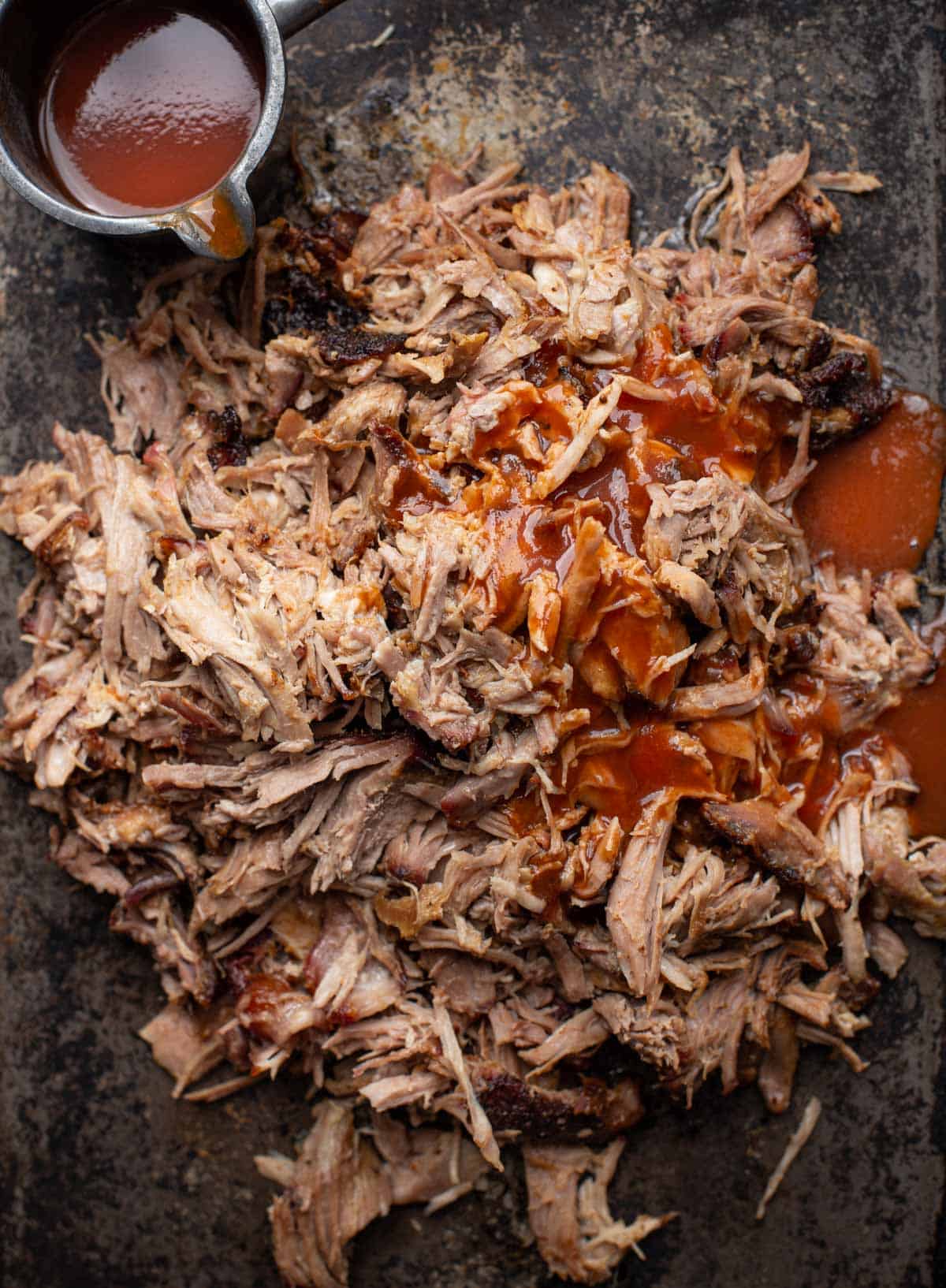
Recipe Highlights
- While there are different ways to smoke this cut of meat, this smoked pork butt method uses smoke and then wrap until finished, which speeds up the cooking time.
- You can use this recipe on bone-in or boneless pork butts.
- The smoking process and fat from the connective tissue make this a great recipe to make ahead and then reheat for a crowd.
- This tried and true recipe works on any kind of smoker, from a pellet smoker to offset, charcoal grill, and everything in between.
Table of Contents
We’ve smoked A LOT of pork butts (also called pork shoulders), hundreds for our consumption, as well as through our professional catering company, Ember and Vine. And we are here to share all we have learned through experimentation, awards, and questions from our community. Follow this guide for the perfect smoked pulled pork flavor and texture.
Recipe Ingredients
- Pork Butt – Buy a 5 – 7 pound pork butt, or Boston butt. Preferably bone-in, but boneless works too. See the FAQ section for more details on selection.
- Dijon Mustard – Mustard works as a binder for the seasoning to stick to the butt. You can use yellow mustard, or even olive oil.
- Seasoning – We use our pork dry rub with a combination of savory, salt, and sweet flavors. Full portions in the recipe card. Or use your favorite pork seasoning.
- Spritz – Equal parts apple cider vinegar and water for some nice acidity.
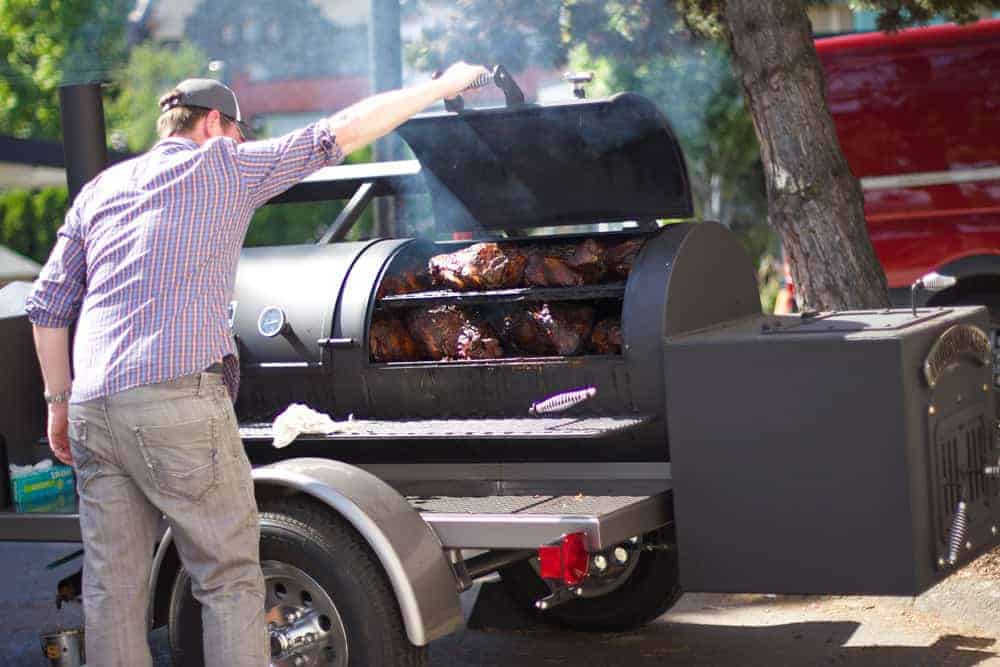
What is Pork Shoulder (Pork Butt)
Pork Butt is a dense muscle from the shoulder of the pig (not the actual butt). The characteristics of the shoulder include pockets of intramuscular fat that are elongated and stringy. Tucked inside the shoulder is another important muscle called the pork collar, or money muscle as it is known in competition barbecue.
The shoulder may be called a number of things depending on how they are cut and can come bone-less or bone-in. We prefer bone-in pork shoulder for smoking because it gives a more uniform shape.
- Whole Pork Shoulder – This is typically a 12 – 14 pound pork shoulder that includes the actual shoulder just off the spine, as well as the upper portion of the leg, or picnic.
- Picnic – The lower portion of the shoulder and the bone in upper portion of the leg. This is easy to spot because it tapers down toward the leg with a triangular shape. These average 6 – 8 pounds.
- Boston Butt/Pork Butt – This is the shoulder that has been separated from the picnic. This cut is typically 6 – 8 pounds. The butt is still the shoulder and not to be confused with the ham, which is the rear of the pig.
- Partial Cuts – At times grocery stores will pre-slice pork shoulders into 3 – 4 pound cuts. We do not recommend using these for smoking.
- Boneless – Any of these cuts can be boneless. The butcher simply removes the bone and may tie the pork shoulder with butcher string.
Butchers Tip – When buying pork shoulder, if you see the word “Roast” be sure it is not Pork Loin. Pork Loin is a separate cooking process. Also if the cuts are small (3 – 4 pounds) ask the butcher if they have untrimmed whole shoulder or Boston Butt. Often they have them and you can trim them yourself.
The best way to cook pork shoulder is to smoke low and slow in order to slowly render the pockets of fat.
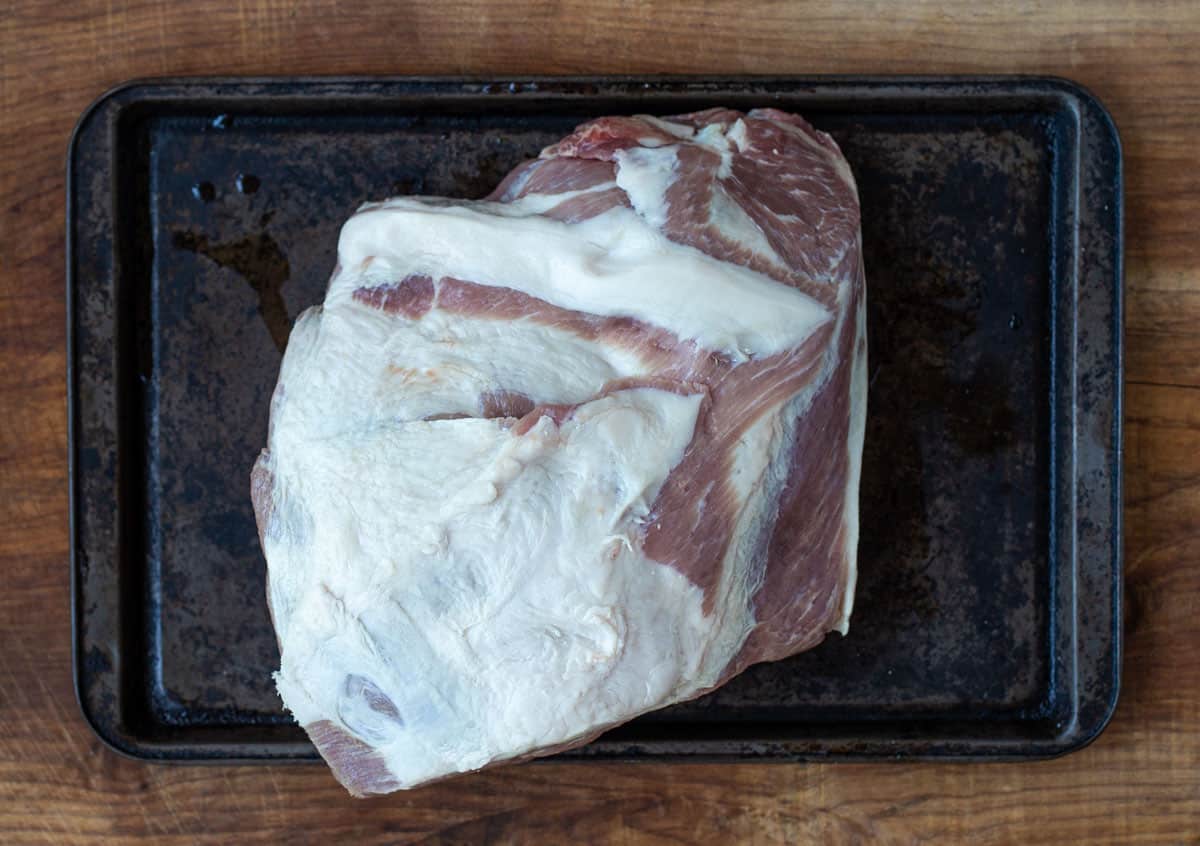
Tools Needed
- Silicone Gloves: These are fantastic when working with hot meat. They are also dishwasher safe, so you are assured you are working with clean and safe gloves. There are several silicone gloves out there, but these are the ones we use.
- Pork Puller: When we’re cooking several pork butts for a crowd we use this pork puller for speed and ease. You just attach it, just like a drill bit, to your drill and pull away. So easy and so awesome to make smoked pulled pork!
- A Good Digital Probe Thermometer: Temperature is key when cooking a large piece of meat like a pork butt. Every transition we make is determined by a specific temperature, so it’s vital to have a good thermometer. We use a Thermoworks Smoke Unit with two-zone tracking, and we also use the Thermoworks Thermapen One to probe the tender meat at the end of the cooking process.
- Aluminum Foil or Pink/Peach Butcher Paper for wrapping.
- For injecting our meat, we use a culinary injector and for a spritz, we use a food-safe spray bottle.
Trimming a Pork Butt
There will be a fat cap on top of the pork butt that needs to be trimmed and some removal of any fatty pockets or potential glands using a sharp boning knife or filet knife.
Many will say to leave a hefty fat cap on the top of the shoulder. I have found that a super thick fat cap does not render out, resulting in a fairly large mass of fat when you’ve cooked it for 10+ hours and the loss of some potential surface area for bark (or that exterior flavor crust created by the smoke).
So my recommendation is to cut that fat cap to barely a ¼ inch on the topside. I actually prefer to shave it down to a razor thin layer. The fat inside the meat is what is more important.

The remaining fat will still render, and you will get more flavor all around the meat. So don’t leave too much fat. Not to mention you still have fat inside the meat that is also rendering for flavor and moisture.
Trim the remaining sides. Sometimes you may see some glands on the non fat cap edges. They will be purple or red, those should come off too as the texture is not pleasant if you leave them on.
Preparation
We prefer to inject first then add the seasoning (using a culinary syringe). We use equal parts apple cider vinegar and apple juice (or water) to get moisture and flavor into the interior of the meat.
When injecting use a food injector and inject the liquid into 1-inch virtual cubes of space, you’ll see the pork expand or bulge. This is fine. Remember, you are going to be cooking this for several hours (10-14 hours depending on size), so that liquid will help keep the meat moist over that long duration of the cook as it warms and steams out.

Like heat? Add some hot sauce to the injection. But in the end it’s adding moisture into the meat, that when warmed up will try to escape the meat and add that flavor all throughout the interior of the meat versus just the rub on the exterior.
Seasoning
We start with a Dijon mustard slather to allow the pork rub to stick (yellow mustard works as well). You can use extra virgin olive oil, beef stock, or any liquid you like. We prefer mustard.
Plan one cup of seasoning for the average 5 to 7 pound shoulder.
The dry rub will adhere to the slather. A good pork seasoning for pork shoulder will contain sugar and be slightly savory. Sugar helps with creating bark, or the dark caramelization that happens when smoking the shoulder. Want more savory? Lessen the sugar and add more salt, garlic, or onion powder.

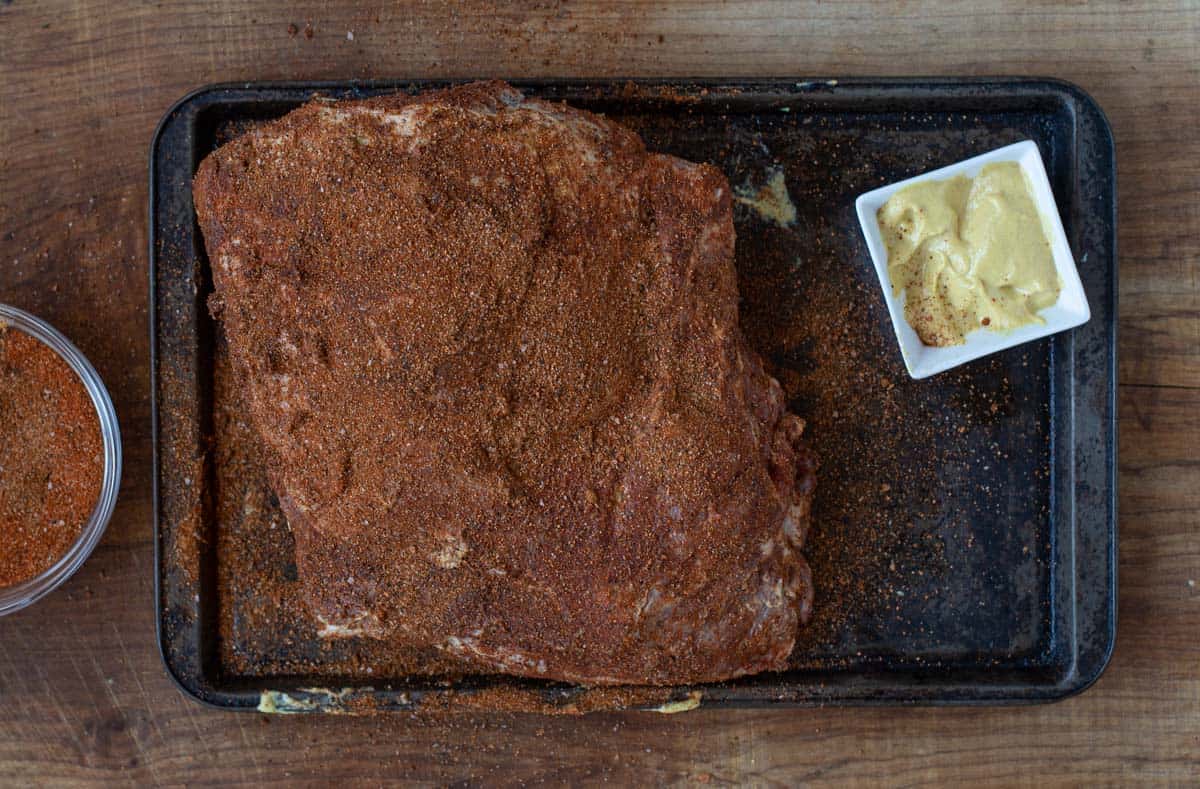
Pork Butt Dry Rub Ingredients:
- Brown Sugar (you can use dark or light)
- Kosher Salt
- Coarse Black Pepper
- Cumin
- Paprika
- Dry Mustard
- Cayenne
Just mix all ingredients in a large bowl. You can season the day of, or the day before. If you have time, do it the day before and then wrap the shoulder in foil or plastic wrap and keep in the refrigerator until ready to smoke.
How to Smoke a Pork Butt
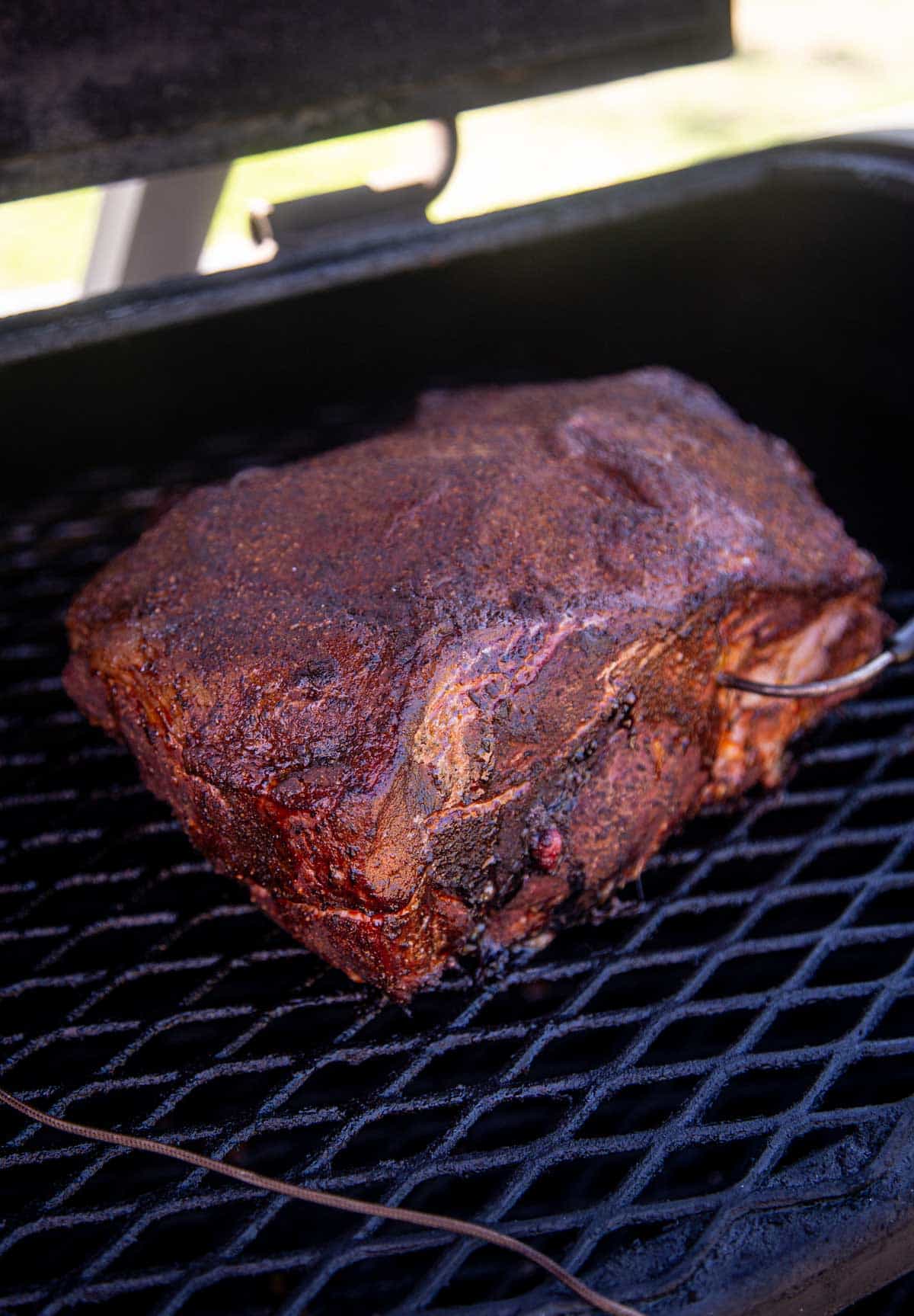
Would you like to save this?
There are phases to smoking a pork shoulder after it has been trimmed and seasoned. Generally, we plan 1 hour and 15 minutes per pound for total cook time, including the rest period.
- Smoke – Target 250 degrees Fahrenheit for the first 3 – 4 hours.
- Spritz – After 3 – 4 hours of smoke, use a spray bottle to lightly spray the shoulder every 30 minutes until the internal temperature of the pork butt reaches 165 degrees F.
- Wrap – After the internal temperature of the pulled pork hits 165 degrees, wrap the shoulder in foil or butcher paper and reinsert your remote probe meat thermometer.
- Continue Smoking – Place back into smoker at 250 degrees, close the lid, and continue cooking until the pork shoulder reaches a range of 190 – 205 degrees F. In this range you will insert an instant read thermometer and check the temperature. When the probe goes into the shoulder it should feel like it’s entering into room temperature butter with no tension. If it is still a little tough, keep cooking. Another test for doneness is pulling on the bone, if it slides right out, it’s done. This process can take an additional 5 – 7 hours depending on the pork shoulder size. They key is cooking to temperature, not time.
- Rest – Remove from the smoker (still wrapped) and place in a cooler (with NO ice) for an hour, covered, to let the tender meat rest. This will allow the shoulder to slowly come down in temperature and redistribute all that amazing flavor and moisture.
- Pull – Use your favorite tool and pull the pork into strings, this is when it becomes pulled pork. There will still be some cartilage and stringy fat. Be sure to discard those as you pull.
See full details in the printable recipe card.
Pulled Pork Spritz
Make sure you have a food safe spray bottle. Fill it with equal parts apple cider vinegar and apple juice (or simply apple cider vinegar and water, which is our preference to cut down on excess sweet).
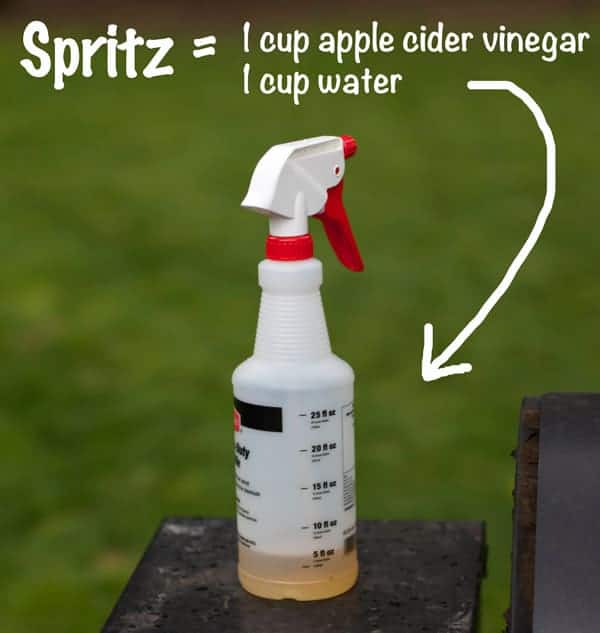
After three to four hours of smoke, spray with this spritz every 30 minutes until you wrap.
As smoke travels through the cooking chamber it is attracted to moisture. So this adds a lot of smoke flavor as the smoke connects with the spritz. We will spritz until the wrap step. It takes only seconds to spritz, so you won’t be losing much heat when you open up your cooker.
How To Wrap Pork Butt
Some choose not to wrap, which is fine, it just takes longer to smoke the pork butt. I elect to wrap, and make sure I do so after the stall, which is when the internal temperature of the meat reaches around 165 degrees F.
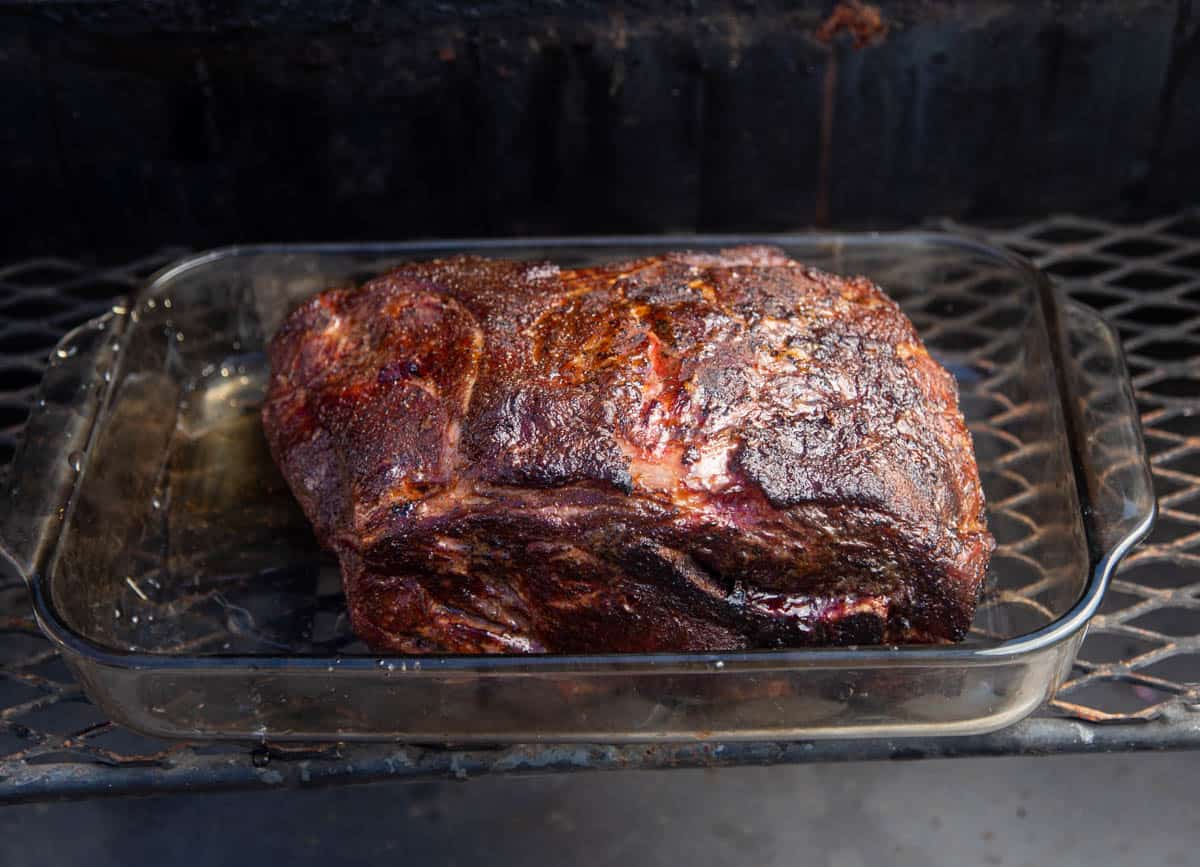
Place shoulder in a large aluminum pan, large baking sheet, or even a glass dish. Add a couple tablespoons of the spritz liquid into the pan and then wrap to top in foil. Insert the remote thermometer probe again through the wrap and then return to the smoker and close the lid. Be sure the probe is not touching the bone.

How Long to Smoke Pork Butt
Plan 1 hour and 15 minutes per pound, on average, when cooking at 250 degrees Fahrenheit.
- 5 pounds: 6-7 hours
- 7 pounds: 8-9 hours
- 8 pounds: 9-11 hours
How to Pull Pork
- If you have given your meat enough time to properly cool to temperature, you can pull with your hands to make the smoked pulled pork. When we’re cooking at an event and have several to pull, we use a tool that attaches to a drill (it’s awesome). It makes it SOOO easy to finish the job.
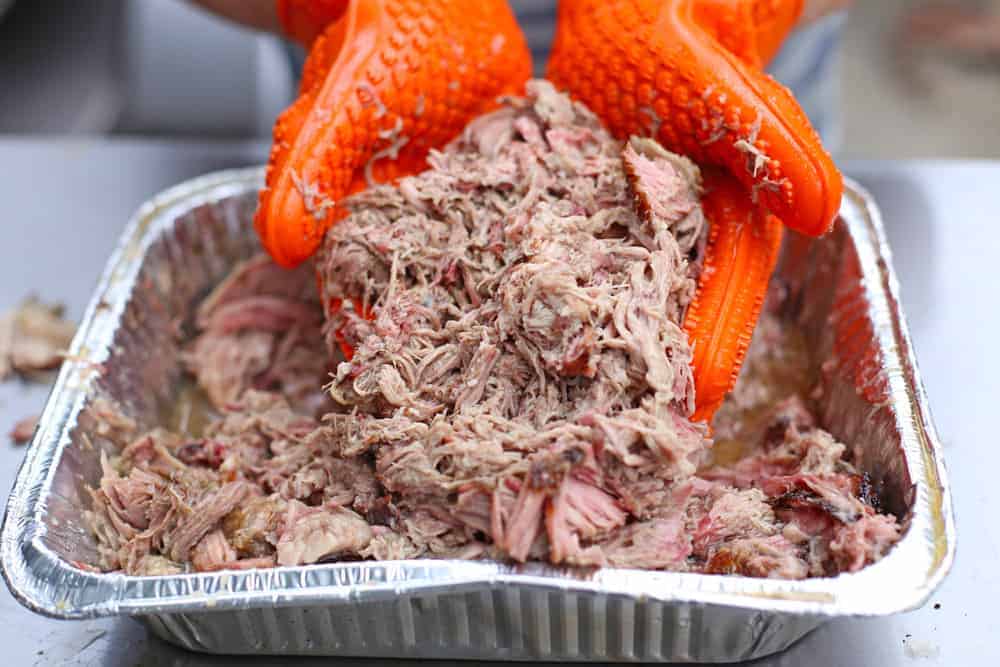
- As you pull you may find some minor pieces of fat or cartilage that you want to discard. Get it pulled to your desired consistency and then cover again until ready to serve.
- Want a little extra flavor? Add some apple cider vinegar after it’s pulled, or add your favorite BBQ sauce if you want.
Frequently Asked Questions (FAQ)
The stall is when the meat sweats liquid while cooking. As the meat sweats from the cells, it cools the meat down again. The stall is represented when you see very little movement in the internal temperature of the pork shoulder. It may be hours and only moves 5 – 6 degrees.
As the moisture cooks out, which is all that intramuscular fat rendering out, the internal temperature of the pork shoulder will start to rise again at a faster pace. When the smoked pork butt internal temperature reaches around 165 – 170 degrees F it is likely out of the stall.
On average it’s an additional 4 to 5 hours from the beginning of the stall until the pork shoulder finishes at 203.
Our favorite wood is fruit wood, like apple wood, cherry, or peach for pulled pork. Fruit woods burn sweeter with less of a campfire flavor.
On average a six pound pork shoulder takes roughly 8 hours to cook. Plan 1 hour and 15 minutes per pound as a general range for a pork shoulder.
With pork shoulder or butt, the marbling is important for a long cook where you are essentially slowly rendering all the fat out throughout the cook, in order to get moisture into the meat.
Look for fresh pink color with no odor. The fat cap and the meat should be firm.
Buy bone-in shoulder. The bone helps keep the uniform squared shape for a shoulder and allows for more even cooking. The bone also acts as a temperature gauge for when the pork is done when it can easily slide out from the shoulder. However if all you can find is boneless, that is fine as this recipe works the same!
No, you do not need to spritz. But it does help with moisture for tender meat and helps with more smoke flavor.
If your pork is tough and dry it was likely overcooked beyond the range of 200 degrees Fahrenheit. You can add apple cider vinegar to the pulled pork butt while warm and it should rehydrate.
It is not required to wrap the pork butt. It will take a little longer for it to cook and you will want to continue to spritz it. You can also check out our no-wrap pork shoulder recipe for more details.
Plan 1/2 pound of meat per person for planning a meal. A 5 pound pork shoulder should feed 10 people when you include sides. If doing sandwiches then plan 2/3rds pound per person.
Expert Tip
Pork Shoulder takes time, be patient and allow the pork butt to cook through the stall and then let it rest. Resting allows the meat to settle and slightly cool making for a tender pork butt.

Storage and Reheating Instructions
You can make smoked pork butt up to 5 days in advance of use. Be sure you have pulled the pork butt first while it’s warm. Store in a large pan covered with aluminum foil (or plastic wrap) with the juices and fat after it’s been pulled.
To Reheat
Preheat oven to 300 degrees. Place pulled pork in an oven-safe dish. Add 1/4 cup of apple cider vinegar or your favorite barbecue sauce and then cover with foil. Place into the oven for 20 minutes. The liquid from the vinegar will steam to rehydrate the smoked pulled pork and the fat will re-liquefy.
Leftover Smoked Pork Butt Ideas
We have an entire round up for pulled pork leftover ideas or try some of our favorites.
- Pork Shoulder Tacos
- Pulled Pork Nachos
- Pulled Pork Spring Rolls
- Leftover Pulled Pork Wontons
- Smoked Pulled Pork Hash
About Vindulge
Mary (a certified sommelier and recipe developer) and Sean (backyard pitmaster) are co-authors of the critically acclaimed cookbook, Fire + Wine, and have been creating content for the IACP nominated website Vindulge since 2009. They live in Oregon on a farm just outside Portland.
This post was originally created in 2016 and has been updated August 2022 with more Q and A and reader questions answered.
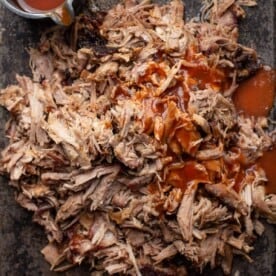
Smoked Pork Butt Recipe
Equipment
- 1 Leave-In Bluetooth Thermometer
- 1 food safe spray bottle
Ingredients
- 8 pound pork shoulder, or boston butt
- 2 tablespoons Dijon mustard
Dry Rub:
- ¼ cup brown sugar
- ¼ cup kosher salt
- 1 tablespoon chili powder
- 1 tablespoon smoked paprika
- ½ tablespoon dry mustard
- ½ tablespoon cumin
- ½ teaspoon cayenne
- 2 teaspoons garlic powder
- 1 teaspoon onion powder
Injection:
- 1 cup apple cider vinegar
- 1 cup apple juice
Spritz:
- 1 cup apple cider vinegar
- 1 cup water
Instructions
For the Pork Dry Rub:
- Mix: Combine all ingredients in a large bowl and mix. Use all the seasoning for the entire pork butt.
For the Spritz:
- Mix: Combine the apple cider vinegar and water in a food safe spray bottle.
How to Smoke Pork Shoulder:
- Trim and Prep Shoulder: Remove excess fat cap, and any glands. Pat dry with a paper towel and then place onto a baking sheet, and inject the meat. Discard any liquid that pools in the pan and then pat dry the pork again. Best to do the night before.
- Season: Apply mustard and then apply dry rub thoroughly. If you don’t have time to do the night before try to apply at least an hour before cooking.
- Preheat Smoker: Prep smoker to 250 degrees Fahrenheit. We use apple or cherry wood.
- Smoke: Place the pork fat cap side up (if you left the cap on), close the lid, and smoke for about three hours. You’ll see a bark begin to develop. If it hasn't then continue smoking one more hour. After you see a mahogany color and bark, spritz (or spray) every 30 minutes and close the lid each time. After about five hours total, check the temperature. When the pork hits on or around 165 degrees Fahrenheit, it’s likely coming out of the stall and ready to wrap. This will change from meat to meat, you will see the temperature hover and only go up in a few degrees per hour. It pushes through the stall when you start to see the temperature increase in a much faster pace (between 165 to 175).
- Wrap: As you complete the stall, (remove the thermometer at this point if you have one) place the pork shoulder into a pan, add a small amount (two tablespoons) of your spritz into the pan and wrap in foil tightly. Put the thermometer back in place.
- Continue Smoking: Continue cooking in the smoker, wrapped, with the lid closed until the internal temperature is between 200 and 203. Use an instant-read thermometer. It should slide right in as if it is entering room-temperature butter.
- Rest: Remove from smoker (but leave wrapped). Place it into a cooler (with NO ice) and let it rest for an hour. It will act as a warmer and keep the pork warm for hours. It also helps with tender meat to let it sit.
- Pull: After one hour, remove and begin pulling the tender meat. Remove the bone (it should slide right out), and then pull with your favorite tool or with your hands. There will likely be some cartilage or other fatty pieces, be sure to pull those out and discard them.
Video
Notes
Nutrition
Nutrition information is automatically calculated, so should only be used as an approximation.
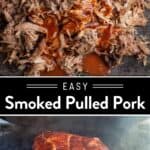
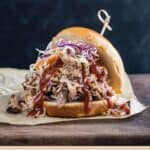





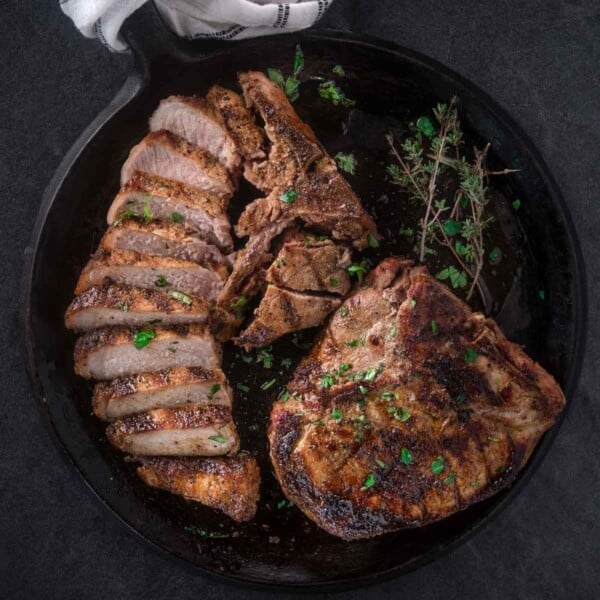



















I am a beginner using a hand me down smoker. I followed the instructions as written with the exception of injecting the meat. It turned out great. The detailed instructions and tips were very helpful. The meat turned out moist and flavorful.
This turned out perfect. We love also love your book. Thank you!!
Jan thank you so much for taking the time to let us know and for buying our book!!! Be sure to rate it wherever you may have purchased it from.:)